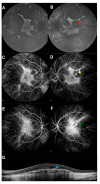Molecular Therapies for Choroideremia
- PMID: 31548516
- PMCID: PMC6826983
- DOI: 10.3390/genes10100738
Molecular Therapies for Choroideremia
Abstract
Advances in molecular research have culminated in the development of novel gene-based therapies for inherited retinal diseases. We have recently witnessed several groundbreaking clinical studies that ultimately led to approval of Luxturna, the first gene therapy for an inherited retinal disease. In parallel, international research community has been engaged in conducting gene therapy trials for another more common inherited retinal disease known as choroideremia and with phase III clinical trials now underway, approval of this therapy is poised to follow suit. This chapter discusses new insights into clinical phenotyping and molecular genetic testing in choroideremia with review of molecular mechanisms implicated in its pathogenesis. We provide an update on current gene therapy trials and discuss potential inclusion of female carries in future clinical studies. Alternative molecular therapies are discussed including suitability of CRISPR gene editing, small molecule nonsense suppression therapy and vision restoration strategies in late stage choroideremia.
Keywords: REP1; choroideremia; gene therapy; inherited retinal disease; treatment.
Conflict of interest statement
REM is a founder and receives grant funding from Nightstar Therapeutics (now Biogen Inc.). REM and ARB are consultants to Nightstar Therapeutics and REM is a consultant to Spark Therapeutics. These companies did not have any input into the work presented.
Figures



References
-
- Van den Hurk J.A., Schwartz M., van Bokhoven H., Van de Pol T.J.R., Bogerd L., Pinckers A.J.L.G., Bleeker-Wagemakers E.M., Pawlowitzki I.H., Rüther K., Ropers H.H., et al. Molecular basis of choroideremia (CHM): Mutations involving the Rab escort protein-1 (REP-1) gene. Hum. Mutat. 1997;9:110–117. doi: 10.1002/(SICI)1098-1004(1997)9:2<110::AID-HUMU2>3.0.CO;2-D. - DOI - PubMed
-
- Tolmachova T., Anders R., Abrink M., Bugeon L., Dallman M.J., Futter C.E., Ramalho J.S., Tonagel F., Tanimoto N., Seeliger M.W., et al. Independent degeneration of photoreceptors and retinal pigment epithelium in conditional knockout mouse models of choroideremia. J. Clin. Investig. 2006;116:386–394. doi: 10.1172/JCI26617. - DOI - PMC - PubMed
Publication types
MeSH terms
Grants and funding
LinkOut - more resources
Full Text Sources
Medical

